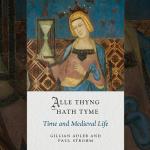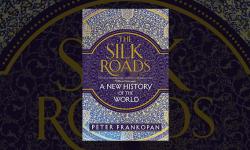Alle Thyng Hath Tyme, Gillian Adler and Paul Strohm
Time is a strange thing: there's always either too little or too much of it; we can waste it or we can spend it; it slips through our fingers or lingers frustratingly. But however we experience it, time is ever-present. For most of us, it determines our days, our weeks, our years. Even these very definitions are time-dependent - constructs invented to make sense of our lives. It is all around us and yet it's unusual to think intellectually about it. It's even rarer to pause to consider how our forebears perceived it, or how these perceptions might have influenced us.
This is where Gillian Adler and Paul Strohm's book comes in. Alle Thyng Hath Tyme is a gentle journey through medieval society's, and people's, experience of time. From the secularNot connected with religious matters. to the divine, it considers the various frameworks through which people living in the High to Late Middle Ages perceived time - the natural and seasonal, the liturgical and religious, the progression from birth to death, and, ultimately, the life of the world from Creation to Judgement. Through this, the reader is shown how individuals understood and used time, how they recorded it and how they organized it. Utilising an enormous array of sources, from sermons to fiction, from the unknown to the great names, and from dusty manuscriptsBooks, documents, or piece of musics written by hand rather than typed or printed. Later, pieces of work that have not yet been published. to glorious church decoration, they explore every aspect to give us a sense of the past's appreciation of time.
That the sources are so extensive should not come as a surprise, for the authors are drawing on years of experience teaching the humanities in American universities. Literary and visual sources combine to create a kaleidoscope of colour and thought, and a momentary sense of the medieval mindset in its many forms. As often as possible, witnesses speak with their own voices and the texts of writers like Chaucer and Malory, mystics like Julian of Norwich and Margery Kempe, and administrators such as Thomas Usk are considered in detail, with supporting roles for many more. The language, where possible, is in the original, providing a feeling for the flow of the language - and therefore the thoughts - of their creators.
If the beauty of this approach is a sense of zeitgeist, the downside is a lack of context. Quotations, while proving the authors' points, can miss vital background information. Petrarch, for example, is bemoaning misspent time not because of the slow and inevitable march towards his own old age and eventual demise, but because he has only just lost significant numbers of friends and loves to the much-less-inevitable Black DeathA deadly disease, also known as plague, that first raised its head in its current form in the 1340s and continued ravaging communities in Europe for the next three and a half centuries.. John Gower is not celebrating old age because it has given him wisdom; instead he is using it as a metaphor for switching political allegiance from Richard II to the usurper Henry IV. The list could go on. The disappointment is that discussion and analysis of these texts, taking in the historical background to them, could render them not just more fascinating but could lead us down new avenues for understanding medieval concepts of time across the period under discussion. For in five hundred years - the period considered in All Thyng Hath Tyme - a lot could, and did, happen: the late Anglo-Saxons - those people depicted in Vikings: Valhalla - had no more in common with the writers of the early RenaissanceA European revival of learning, art and literature influenced by classical history and culture. It started in Florence, Italy in the 14th century and spread to the rest of Europe in the 14th to 16th centuries. than we do.
But then again, this book is not straight history, with its cause and effect and its linear progression. It is, instead, as nebulousHazy, vague, or ill-defined. an idea as time itself - a fleeting image both haunting and enchanting. It can linger, and it can accelerate, but it still ensnares: the reader will still be caught by its web. In its own way, Alle Thyng Hath Time rests between the tick and the tock, just as time did for medieval people.
- Log in to post comments







